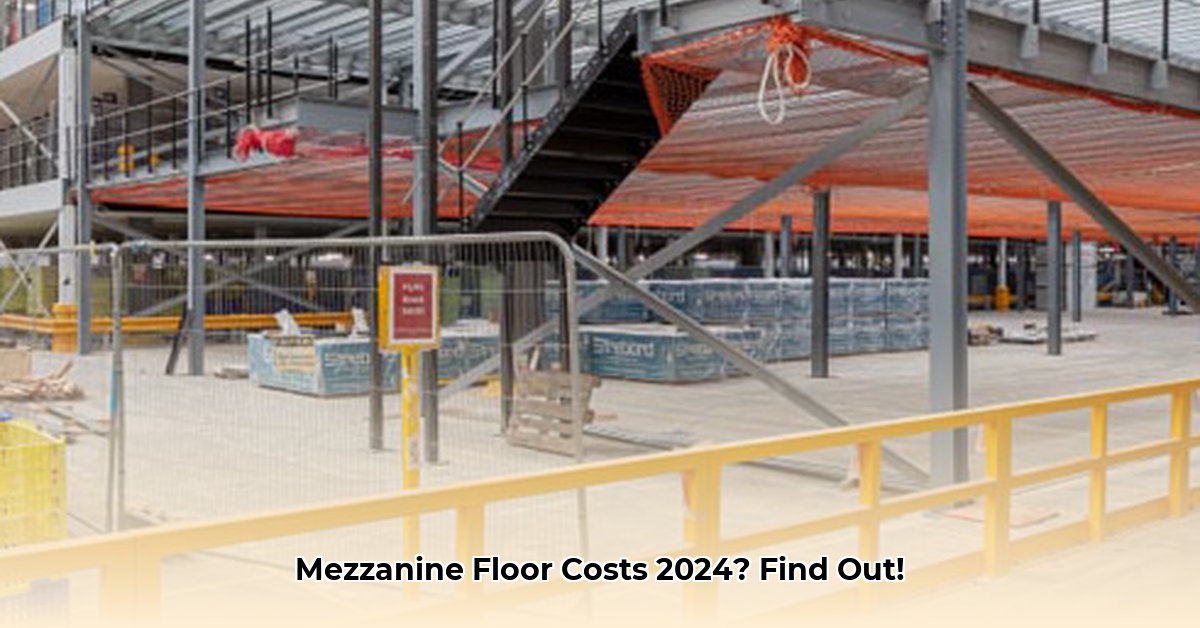Maximize your space with a mezzanine floor! This comprehensive guide reveals 2024 costs, essential factors, and expert tips. Get a free, personalized quote and make informed decisions. For more detailed pricing information per square meter, see this helpful resource: Mezzanine Floor Costs.
Understanding Mezzanine Floor Pricing and Key Cost Factors
A mezzanine floor can dramatically increase usable space in homes, offices, warehouses, and retail environments. If you’re considering this cost-effective expansion, understanding the pricing structure is essential. Instead of moving or expanding outward, a mezzanine adds a valuable level within your existing structure.
The cost of a mezzanine floor isn’t a fixed number; it depends on different elements. Think of it like buying a car – a basic model has a base price, but adding features increases the final price. Mezzanine floors typically range from $40 to $250 per square foot. Here’s a breakdown of the factors influencing the wide range in price.
Key Elements Affecting Mezzanine Cost
Several factors affect the price of your mezzanine project. Understanding these elements is the first step in creating an accurate budget.
- Size and Square Footage: The most obvious factor. Larger mezzanines require more materials and labor, resulting in higher costs.
- Material Choice and Availability: The materials used significantly impact the price. Steel is a popular choice due to its strength and durability. However, market fluctuations affect the cost. Wood or aluminum can also be used.
- Design Complexity and Customization: A simple rectangular design will be less expensive than a complex custom design. Integrated staircases, specialized railings, complex shapes, or unique aesthetic features increase costs.
- Load-Bearing Requirements: The intended use of the mezzanine dictates its load-bearing requirements. Heavier loads require sturdier construction, directly impacting material and labor costs.
- Location and Labor Costs: Labor costs vary by location, impacting the overall project cost. Highly skilled labor is essential for safety and proper installation. Urban areas generally have higher labor prices.
- Building Codes and Permits: Compliance with local building codes is non-negotiable. Permitting fees and inspections contribute to the expense.
- Installation Complexity: Difficult access to the site, congested work areas, or the need to work around existing operations can increase complexities and cost.
Mezzanine Floor Cost Examples and Budget Allocation
Understanding realistic cost scenarios will help you budget appropriately.
- Basic Storage Mezzanine: A basic storage mezzanine with standard features typically ranges from $40 to $70 per square foot. This includes essential materials, freight, and installation.
-
Commercial/Retail Mezzanine: Mezzanines designed for office or retail use, with enhanced aesthetics and features, generally range from $70 to $150 per square foot.
-
Complex Custom Mezzanine: Highly customized mezzanines with unique architectural features and specialized requirements can range from $150 to $250+ per square foot.
Getting Accurate Quotes: Step-by-Step
To avoid unpleasant surprises, follow this step-by-step guide to get accurate quotes:
- Identify Reputable Professionals: Research experienced mezzanine contractors. Check online reviews (Google, Better Business Bureau), request references, and verify licensing and insurance.
- Define Project Scope: Develop detailed project specifications. Include accurate measurements, intended use, load requirements, material preferences, and desired features (stairs, railings, lighting). Detailed plans ensure accurate bids.
- Obtain Multiple Quotes: Contact at least three to five contractors for detailed quotes.
- Compare and Analyze Quotes: Carefully compare each quote, ensuring all include the same specifications: materials, labor, permits, warranty, and a clear breakdown of all costs. Scrutinize quotes for hidden fees.
Construction Risks and Mitigation Strategies for Success
Construction projects come with inherent risks. Mitigating these risks is crucial for staying on budget and schedule.
- Material Price Fluctuations: Secure price guarantees from suppliers or explore alternative materials to hedge against unexpected increases.
- Permitting and Approval Delays: Work with experienced contractors familiar with local building codes and permitting processes.
- Installation Errors and Safety Concerns: Choose licensed and insured contractors with a proven safety record. Prioritize safety to protect your investment.
- Unexpected Structural Issues: Conduct a thorough structural assessment before installation to identify and address potential issues.
Long-Term Investment Considerations for Mezzanine Floors
A mezzanine floor is a long-term investment. Consider these factors for maximizing its value:
- Maintenance and Inspections: Implement a regular maintenance schedule to identify and address potential problems early, preventing costly repairs.
- Return on Investment (ROI): Analyze how the mezzanine increases space utilization, improves efficiency, and enhances productivity.
- Property Value Appreciation: A well-designed and properly installed mezzanine can increase your property’s market value.
With careful planning and the right team, a mezzanine floor can be a cost-effective way to expand your space and enhance your property value.
How To Get Accurate Mezzanine Floor Cost Estimates For Complex Designs
Creating complex mezzanine designs requires precise cost planning and a keen understanding of the various elements involved. Here’s how to get an accurate estimate.
Influencing Elements: Design to Budget
Complex mezzanine projects are like custom-built machines. The following factors influence your final bill:
- Size and Scale: Larger, more extensive mezzanines require more materials and labor.
- Material Specifications: Steel, aluminum, wood, and composite materials each carry different price points and structural properties.
- Design Intricacy: Custom staircases, elevated walkways, complex support structures, and architectural features all affect costs.
- Geographic Location: Labor rates, material availability, and transportation costs vary significantly by region.
- Intended Use and Load Requirements: Heavy storage or specialized equipment requires stronger, more expensive materials and engineering.
Cost Ranges and Examples:
Cost ranges can vary significantly. Basic warehouse mezzanines start around $40 per square foot. Intricate designs can exceed $250 per square foot. Location greatly affects pricing.
Step-by-Step: Precision Estimation
Follow these steps to obtain a precise budget:
- Select Qualified Contractors: Find experienced contractors specializing in complex mezzanine installations. Check portfolios, verify credentials, and solicit references.
- Prepare Detailed Specifications: Develop comprehensive plans including precise dimensions, material preferences (steel, wood), design details (staircases, railings), and load requirements.
- Obtain Multiple Bids: Request detailed quotes from at least three qualified contractors.
- Analyze Bids: Carefully compare each quote, ensuring that all include the same specifications, materials, labor, permits, warranties, and a clear breakdown of all costs.
Risk Mitigation: Anticipate Challenges
Mitigating risks is critical:
- Project Delays: Choose contractors with a proven track record of on-time project completion.
- Material Price Volatility: Secure price guarantees from suppliers or explore alternative materials.
- Building Code Compliance: Consult local building authorities early to ensure full compliance with all regulations.
- Structural Integrity: Hire qualified engineers to ensure accurate load calculations and structural design.
Long-Term Considerations: Making it Last
Consider maintenance, ROI, and property value when planning:
- Ongoing Maintenance: Budget for regular inspections and maintenance to extend the mezzanine’s lifespan.
- Return on Investment (ROI): Calculate how the mezzanine increases usable space and improves overall profitability.
- Property Value Appreciation: A well-built mezzanine can improve the overall value of your property.
Key Takeaways:
- Plan thoroughly.
- Engage qualified professionals.
- Anticipate potential risks.
- Consider long-term value.
Mezzanine Floor Cost for Retail Spaces in Urban Areas: Balancing Space and Budget
Adding a mezzanine to a retail space in an urban setting presents unique opportunities and challenges. Here’s what to consider about costs:
Elements That Can Influence The Price: Urban Retail Specifics
Several common elements play key roles in determining the final price. Thinking of it like building with LEGOs – complex designs need more pieces.
- Size and Square Footage: Larger mezzanines demand more materials and labor.
- Material: Choices like steel (durable), aluminum (lighter), or wood (aesthetic) affect cost.
- Design Complexity: Simple, functional designs are cheaper than intricate custom work.
- Location: Urban areas usually mean higher labor costs, stricter regulations, and potentially more expensive materials.
- Accessibility: Limited access for construction equipment and materials in urban areas can increase labor costs and project timelines.
- Building Codes and Regulations: Urban areas often have stringent building codes and fire safety regulations, requiring specialized materials and design considerations.
Examples of Factors that Increase Costs in Urban Retail Spaces:
- Fire Suppression Systems: Urban regulations often require advanced fire suppression systems.
- ADA Compliance: Ensuring accessibility for all customers can necessitate ramps or lifts, adding to the budget.
- Soundproofing: Mitigating noise transfer to neighboring businesses apartments can require extra soundproofing materials.
- Glass Wall Tile Ideas for Kitchens and Bathrooms - December 6, 2025
- Glass Tile Bathroom: Create a Beautiful, Easy-Clean Space - December 5, 2025
- Glass Tile: Brighten Your Home With Stylish Glass Backsplashes - December 3, 2025










